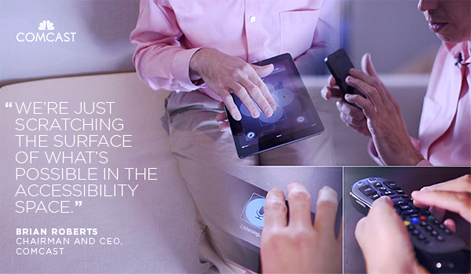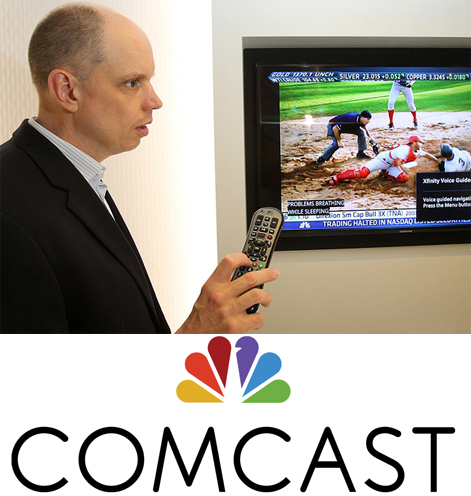| |
X1
TALKS:
Comcast
launches
industry's
first
voice
guided
TV
interface
“Talking
Guide”
Reads
Aloud
Channel
Names,
Show
Titles
and DVR
Commands;
Allows
For
Independent
Search
and
Discovery
For
People
With
Disabilities
By HB
Meeks/Tell
Us
Detroit
PLYMOUTH,
MI -
Comcast
today
announced
the
industry’s
first
voice-enabled
television
user
interface,
a
solution
that
will
revolutionize
the way
its
Xfinity
TV
customers,
especially
those
who are
blind or
visually
impaired,
navigate
the X1
platform.
The
“talking
guide”
features
a female
voice
that
reads
aloud
selections
like
program
titles,
network
names
and time
slots as
well as
DVR and
On
Demand
settings.
The
feature
will be
available
to all
X1
customers
in the
next few
weeks.
About 19
million
U.S.
households
have at
least
one
member
with a
disability
and
according
to the
U.S.
Census,
there
are 8.1
million
people
with a
visual
disability.
In 2012,
Comcast
hired
Tom
Wlodkowski
as Vice
President
of
Audience
to focus
on the
usability
of the
company’s
products
and
services
by
people
with
disabilities.
“Television
is
universally
loved,
and we
want
everyone
to be
able to
enjoy
it,”
Brian
Roberts,
Chairman
and CEO,
Comcast
“The
talking
guide
feature
will
enable
all of
our
customers
to
experience
the X1
platform
in a new
way, and
give our
blind
and
visually
impaired
customers
the
freedom
to
independently
explore
and
navigate
thousands
of shows
and
movies.
We’re
just
scratching
the
surface
of
what’s
possible
in the
accessibility
space
and we
are
thrilled
to have
Tom and
his team
leading
the
charge.”

The
talking
guide
“speaks”
what’s
on the
screen
as the
viewer
navigates
the
“Guide,”
“Saved,”
“On
Demand,”
and
“Settings”
sections
of X1
and
includes
details
like
individual
program
descriptions
and
ratings
from
Common
Sense
Media
and
Rotten
Tomatoes
that
help
viewers
decide
what to
watch.
Future
versions
of the
feature
will
include
functionality
within
the
“Search”
section
of X1
and
additional
personalization
settings
like
rate of
speech.
“The
talking
guide is
as much
about
usability
as it is
about
accessibility,”
said Mr.
Wlodkowski.
“We
think
about
accessibility
from the
design
of a
product
all the
way
through
production
and this
feature
is the
result
of years
of work
by our
team
including
customer
research,
focus
groups
and
industry
partnerships.
For
people
like me
who are
blind,
this new
interface
opens up
a whole
new
world of
options
for
watching
TV.”
X1
customers
will be
able to
activate
the
talking
guide on
their
existing
set top
box by
tapping
the “A”
button
twice on
their
remote
control.
The
feature
also can
be
turned
on via
the
“accessibility
settings”
within
the main
settings
menu.
Here’s
how it
works.

“Programming
my DVR
is one
of the
most
empowering
things I
have
ever
done
with my
TV,”
said
Eric
Bridges,
Director
of
External
Relations
and
Policy
Development
at The
American
Council
of the
Blind (ACB),
who
participated
in a
Comcast
customer
trial
over the
summer.
“My wife
and I
are both
blind,
so
thanks
to this
new
feature,
we no
longer
have to
choose
between
going
out to
dinner
or
catching
our
favorite
show.
The
talking
guide
encourages
independence
and
self-sufficiency;
it’s a
real
game-changer
for
anyone
who is
blind
and
loves
TV.”
Next
year,
Comcast
plans to
partner
with
service
organizations
and
nonprofits
to
create
awareness
in the
disability
community
of Voice
Guidance
and
other
accessibility
features
that
offer a
more
inclusive
entertainment
experience.
“TV is
such an
important
and
integral
part of
the
fabric
of our
culture
that to
be
excluded
from
that
experience
in any
way
makes it
more
difficult
for
blind
people
to
participate
fully in
society,”
said Amy
Ruell, a
Comcast
customer.
“I had a
chance
to test
this
feature
over the
summer
and I
probably
watch
more TV
than
ever
thanks
to the
talking
guide.
Comcast’s
commitment
to
accessibility
is
encouraging
because
it means
there
will be
tremendous
progress
in
developing
technology
that is
universally
accessible.”

The
talking
guide is
the
latest
in a
series
of
innovations
created
in the
Comcast
Accessibility
Lab. In
addition
to voice
guidance
and
one-touch
access
to
closed
captioning,
Comcast
created
an
online
help and
support
resource
for
Xfinity
customers
looking
for
information
about
accessibility-related
topics.
The
webpage
includes
an
overview
of
accessibility
products
and
services,
support
for
third-party
assistive
devices,
information
related
to
Braille
or
large-print
bills
and the
ability
to
connect
with
accessibility
support
specialists.
The
company
also has
a
service
center
specifically
dedicated
to
customers
with
disabilities.
Comcast’s
Accessibility
Center
of
Excellence
is based
in
Pensacola,
FL,
where a
team of
specially
trained
care
agents
handles
about
10,000
calls
each
month.
For more
information,
view our
Press
Kit on
the
technology.
Also,
follow @comcast
for
additional
news and
updates.
|